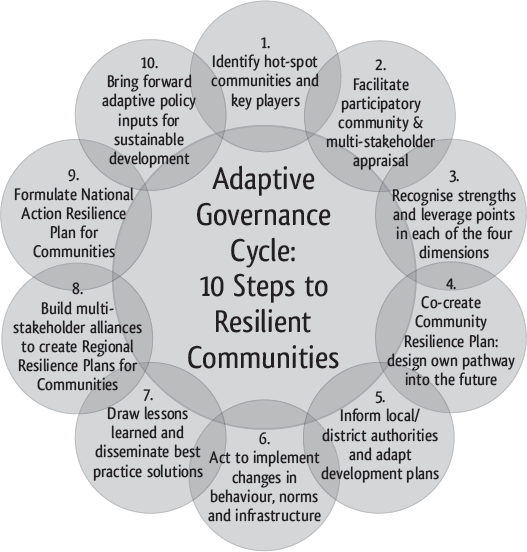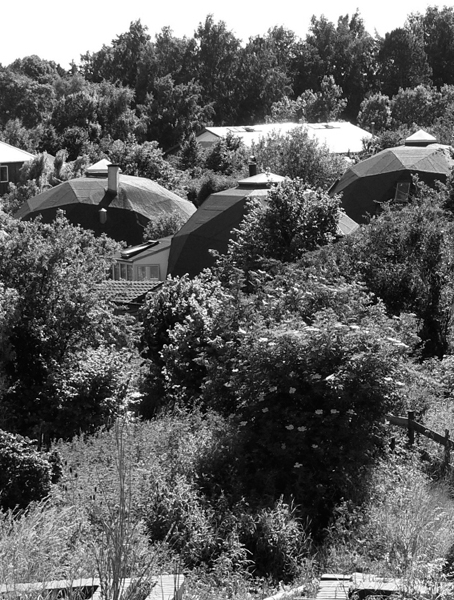
In April 2014 the Intergovernmental Panel on Climate Change (IPCC) published the third part of a trilogy of reports compiled by thousands of the world’s most eminent scientists, giving the most accurate and up to date account of climate change. The first report, released in September 2013, showed that climate change was ‘unequivocally’ caused by human activity. The second, published in March 2014, warned that the impact of global warming, from extreme weather patterns to reduced food production, posed a grave threat to humanity and could lead to wars and mass migration. The third draft report, published in April 2014 stated that the world must urgently switch to clean, renewable sources of energy.
Community-led responses to climate change are a necessary part of any whole system change towards resilient societies. Already in 2009, the vice-president of the IPCC, Mohan Munasinghe, speaking about the importance of the role of citizens in regard to climate protection, said: ‘Change needs to come from the grassroots level, simply because the establishment moves only very slowly.’
The Global Ecovillage Network (GEN), set up in 1995, is an umbrella organisation working to support the experimental creation and preservation of low impact lifestyles across the globe. GEN serves as an alliance between rural and urban, traditional and intentional communities, and encompasses communities with some of the lowest recorded per capita carbon footprints. Through the sharing of best-practice and innovative solutions, and the honouring of deep-rooted traditional knowledge and local cultures, GEN is creating a pool of wisdom for sustainable living on a global scale. GEN supports the paradigm of thinking globally while acting locally.
GEN-International works through five broad regional organisations: the Ecovillage Network of the North Americas (ENA), the Latin American Ecovillage Network (El Consejo de Asentamientos Sustentables de las Américas / CASA), GEN Oceania and Asia (GENOA), GEN-Europe/Middle East (GEN-Europe), and GEN-Africa. These networks make visible the impressive work done by at least ten thousand communities on the ground in more than one hundred countries worldwide.
So what is an Ecovillage?
Ecovillages are intentional or traditional communities, consciously designed through locally-owned, participatory processes to regenerate social and natural environments. The four dimensions of sustainability (ecology, economy, social and cultural) are integrated into a holistic sustainable development model that is adapted to local requirements.
Ecovillages combine a supportive and high-quality social environment with a low-impact way of life. Rapidly gaining recognition as demonstration sites of sustainability in practice, Ecovillages are increasingly places of inspiration for the wider society that is trying to find answers to climate change and peak oil (see below, Chapter 12). They demonstrate that it is within human capacity for communities to consciously enhance and improve their social and natural environments. As such, they are precious playgrounds in which civil society engagement can come to the fore.
As the IPCC reports show, we urgently need to learn how to design societal change processes: every village and every city needs to become sustainable and needs to start regenerating their natural and social environments if we are to find a healthy response to climate change. One of the core questions GEN is facing is, therefore, how the Ecovillage approach can be disseminated at scale without losing its core value of locally owned, participatory processes?
We also know that however important the role of civil society efforts in whole-society change processes may be, for them to become truly effective and influential, they need to be closely coordinated with benevolent governmental and corporate support and collaboration.
Fortunately we can learn from current examples in Senegal and Thailand, where such bridges between civil society, governmental decision makers, and the corporate sector have been built in order to support community-led responses to climate change on regional and national levels.
In Senegal, a network of forty-five Ecovillages came into being following the delivery of educational sustainability programs (forerunners of the Ecovillage Design Education), soon after the establishment of GEN. In 2002 GEN Senegal was established to provide a forum where civil society could showcase best-practices (integration of solar cookers, drip irrigation, permaculture design, reforestation programs, etc.) and demonstrate the potential of an Ecovillage approach for sustainable development. The Senegalese government, inspired by the work done on the ground, then established the Senegalese National Agency for Ecovillages, ANEV, positioned within the Ministry of Environment and Sustainable Development. Today, Senegal is the first country in the world to create an integrated national Ecovillage transition program dedicated to transitioning 14,000 traditional villages to Ecovillages. At the time of writing, similar, more regional, programs are emerging in Thailand and possibly Burma.
In such programs, Ecovillage transition strategies are scaled up, not through replication of a standardised model, but through diffusion and local adaptation of the underlying principles. The participatory nature of such processes necessitates learning from and working closely with each of the communities involved (for the example of Kartong, Gambia, see Appendix 2 on the Ecovillage Design Mandala). Every Ecovillage will be different. Such a journey of self-empowered local change can be unleashed through an Ecovillage Design Education (or a Permaculture Design Course). A process like the Transition to Resilience journey can be used as follow-up to ensure successful implementation. A combination of such trainings functions as a support system for a local community not only to design their own pathway into the future (a ‘Community Resilience Plan’, see below), but also for them to aim to influence good governance and effective implementation through a bottom-up ‘Adaptive Governance Cycle’.
Such a cycle starts by:
• Identifying hot-spot communities and key players in the region or country.
• Facilitating a participatory community and multi-stakeholder appraisal of the community context.
• Recognising the strengths and leverage points in each of the four dimensions (ecology, economy, social and cultural) within the community context.
• Co-creating a Community Resilience Plan with all relevant local actors.
• Working with local/district authorities to integrate this plan within wider development plans.
• Acting to implement the Community Resilience Plan.
Once this has happened, and thus an Ecovillage transition process has taken place, we can go on to:
• Draw lessons learned and disseminate best-practice solutions across regions.
• Build multi-stakeholder alliances to work with local and district authorities on Regional Resilience Plans for Communities.
• Work with national governments on formulating National Action Resilience Plans for Communities.
• Bring forward adaptive policy inputs to strengthen sustainable development strategies on a national level.
In order to support societal transition, we need to marry bottom-up with top-down processes. This Adaptive Governance Cycle enables local solutions to be woven into new tapestries for resilient societies. We come a step closer to establishing a true democracy that trusts in the inherent wisdom and goodwill of its citizens and their willingness to be part of the solution.
(This article was originally published as ‘Ecovillage Transition: Scaling up community led change processes’.)


View over Dyssekilde Ecovillage in Denmark.